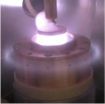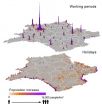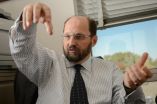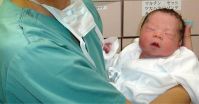(Press-News.org) When researchers at General Electric Co. sought help in designing a plasma-based power switch, they turned to the U.S. Department of Energy's (DOE) Princeton Plasma Physics Laboratory (PPPL). The proposed switch, which GE is developing under contract with the DOE's Advanced Research Projects Agency-Energy, could contribute to a more advanced and reliable electric grid and help to lower utility bills.
The switch would consist of a plasma-filled tube that turns current on and off in systems that convert the direct current (DC) coming from long-distance power lines to the alternating current (AC) that lights homes and businesses; such systems are used to convert AC power to DC power as well. The tube would serve as a compact, less costly alternative to the bulky assemblies of semiconductor switches now installed in power-conversion systems throughout the grid.
To assist GE, PPPL used a pair of computer codes to model the properties of plasma under different magnetic-field configurations and gas pressures. Scientists used a customized LSP PIC-MCC code that follows millions of virtual plasma electrons and ions to simulate the switch in both one and two dimensions, and compared the 1D results with those produced by a one-dimensional EDIPIC code that has been extensively used to study plasma propulsion devices. Researchers then validated the models by comparing them with results from past experiments.
GE has also consulted with PPPL about developing a method for protecting the liquid-metal cathode — the negative terminal inside the tube — from damage from the ions carrying the current that will flow through the plasma. The company has been studying PPPL's use of liquid lithium, which the Laboratory employs to prevent damage to the divertor that exhausts heat in a fusion facility. The lithium forms a wet, self-healing barrier that could serve as a model for the GE cathode.
INFORMATION:
Contact:
Johan Carlsson (PPPL) johan@uwalumni.com
Alex Khrabrov (PPPL) akhrabro@pppl.gov
Igor Kaganovich (PPPL) ikaganov@pppl.gov
Timothy Summerer (GE) timothy.sommerer@ge.com
Abstract:
GP8.00110: Low-temperature simulations with the LSP PIC code
9:30 AM–12:30 PM, Tuesday, October 28, 2014
Room: Preservation Hall
Session GP8: Poster Session III: DIII-D Tokamak; Computer Simulation Methods
9:30 a.m. Tuesday, October 28, 2014
Room: Preservation Hall
Helping general electric upgrade the US power grid
News from the 2014 APS Division of Plasma Physics Meeting
2014-10-28
ELSE PRESS RELEASES FROM THIS DATE:
European consensus on methodological recommendations for clinical studies in rare cancers
2014-10-28
One out of every five new cancer patients is diagnosed with a rare cancer, yet the clinical evidence needed to effectively treat these rare cancer patients is scarce. Indeed, conventional cancer clinical trial methodologies require large numbers of patients who are difficult to accrue in the situation of rare cancers. Consequently, building clinical evidence for the treatment of rare cancers is more difficult than it is for frequent cancers.
Dr. Jan Bogaerts, EORTC Methodology Vice Director, points out, "For rare cancers, we need alternative ways to conceive study designs ...
Lack of A level maths leading to fewer female economists
2014-10-28
A study by the University of Southampton has found there are far fewer women studying economics than men, with women accounting for just 27 per cent of economics students, despite them making up 57 per cent of the undergraduate population in UK universities.
The findings suggest less than half as many girls (1.2 per cent) as boys (3.8 percent) apply to study economics at university, while only 10 per cent of females enrol at university with an A level in maths, compared to 19 per cent of males.
"This underrepresentation of women economics degrees could have major implications ...
Physicists' simple solution for quantum technology challenge
2014-10-28
A solution to one of the key challenges in the development of quantum technologies has been proposed by University of Sussex physicists.
In a paper published today (28 October) in Nature Communications, Professor Barry Garraway and colleagues show how to make a new type of flexibly designed microscopic trap for atoms.
Quantum technology devices, such as high-precision sensors and specialised superfast computers, often depend on harnessing the delicate interaction of atoms. But the methods for trapping these tiny particles are hugely problematic because of the atoms' ...
Technique uses bacteria's own CRISPR-Cas system to turn off gene
2014-10-28
Researchers from North Carolina State University have developed a technique that co-opts an immune system already present in bacteria and archaea to turn off specific genes or sets of genes – creating a powerful tool for future research on genetics and related fields.
"This should not only expedite scientific discovery, but help us better engineer microbial organisms to further biotechnology and medicine," says Dr. Chase Beisel, an assistant professor of chemical and biomolecular engineering at NC State and senior author of a paper on the work. "For example, this ...
Researchers prove accuracy of mobile phone population mapping
2014-10-28
A study by an international team, including the University of Southampton, has shown population maps based on anonymous mobile phone call record data can be as accurate as those based on censuses.
Their findings show maps made using mobile records are detailed, reliable and flexible enough to help inform infrastructure and emergency planners; particularly in low income countries, where recent population density information is often scarce.
Southampton geographer and senior author on the study, Dr Andy Tatem, says: "Proving the resilience and accuracy of using mobile ...
Self-reported sleep disturbances are linked to higher risk for Alzheimer's disease in men
2014-10-28
In a new study, researchers from Uppsala University demonstrate that elderly men with self-reported sleep disturbances run a higher risk of developing Alzheimer's disease than men without self-reported sleep disturbances. The results are published in the scientific journal Alzheimer's & Dementia.
The researchers followed more than 1,000 men, who were initially 50 year old, between the years 1970 and 2010. The results of the study show that self-reported sleep disturbances were linked to an increased risk for Alzheimer's disease during the 40-year follow-up period, particularly ...
The early chimp gets the fig
2014-10-28
This news release is available in German.
How do our close relatives, the chimpanzees, acquire sufficient food when times are lean? By studying wild chimpanzees in the Taï National Park in Côte d'Ivoire researchers of the Max Planck Institute for Evolutionary Anthropology in Leipzig, Germany, provide a clear example of how great apes can acquire extra energy needed to maintain large, costly brains. They show that chimpanzees make their sleeping nests more en route to breakfast sites containing fruits that are more competed for by other daytime fruit-eaters ...
Lessons learned from SARS pandemic should inform current contagion protocols
2014-10-28
In 2003, a novel coronavirus caused a pandemic that affected 26 countries. Severe Acute Respiratory Syndrome (SARS) was most prevalent in Asia; the number of cases in Singapore was second only to China.
In an article published in the American Journal of Roentgenology (AJR), a group of radiologists in Singapore outline the ways in which both medical facilities and practitioners there have incorporated lessons learned from the SARS pandemic.
"The pandemic served as a wake-up call for the medical services, which had to respond and reorganize quickly to meet the rapidly ...
Do financial experts make better investments?
2014-10-28
EAST LANSING, Mich. --- Financial experts do not make higher returns on their own investments than untrained investors, according to research by a Michigan State University business scholar.
The first-of-its-kind study analyzed the private portfolios of mutual fund managers and found the managers were surprisingly unsuccessful at outperforming nonprofessional investors. The findings suggest average investors might be better served to handle their own portfolios rather than pay the often-high fees charged by mutual fund managers, said Andrei Simonov, associate professor ...
Identifying the biological clock that governs female fertility
2014-10-28
Researchers at the University of Gothenburg have identified the biological clock that governs female fertility. The discovery represents a major contribution to research aimed at finding medical approaches to treating infertility in women.
Some women can have successful pregnancies at the age of 50, whereas other are unable to get pregnant when they are 30. Researchers are not yet able to fully explain such differences. One factor is that the onset of menopause is influenced by the point at which the uterus runs out of eggs to release.
A recent study at the University ...
LAST 30 PRESS RELEASES:
How the parasite that ‘gave up sex’ found more hosts – and why its victory won’t last
When is it time to jump? The boiling frog problem of AI use in physics education
Twitter data reveals partisan divide in understanding why pollen season's getting worse
AI is quick but risky for updating old software
Revolutionizing biosecurity: new multi-omics framework to transform invasive species management
From ancient herb to modern medicine: new review unveils the multi-targeted healing potential of Borago officinalis
Building a global scientific community: Biological Diversity Journal announces dual recruitment of Editorial Board and Youth Editorial Board members
Microbes that break down antibiotics help protect ecosystems under drug pollution
Smart biochar that remembers pollutants offers a new way to clean water and recycle biomass
Rice genes matter more than domestication in shaping plant microbiomes
Ticking time bomb: Some farmers report as many as 70 tick encounters over a 6-month period
Turning garden and crop waste into plastics
Scientists discover ‘platypus galaxies’ in the early universe
Seeing thyroid cancer in a new light: when AI meets label-free imaging in the operating room
Neutrophil-to-lymphocyte ratio may aid risk stratification in depressive disorder
2026 Seismological Society of America Annual Meeting
AI-powered ECG analysis offers promising path for early detection of chronic obstructive pulmonary disease, says Mount Sinai researchers
GIMM uncovers flaws in lab-grown heart cells and paves the way for improved treatments
Cracking the evolutionary code of sleep
Medications could help the aging brain cope with surgery, memory impairment
Back pain linked to worse sleep years later in men over 65, according to study
CDC urges ‘shared decision-making’ on some childhood vaccines; many unclear about what that means
New research finds that an ‘equal treatment’ approach to economic opportunity advertising can backfire
Researchers create shape-shifting, self-navigating microparticles
Science army mobilizes to map US soil microbiome
Researchers develop new tools to turn grain crops into biosensors
Do supervised consumption sites bring increased crime? Study suggests that’s a myth
New mass spec innovation could transform research
Maternal nativity, race, and ethnicity and infant mortality in the US
Migration-related trauma among asylum seekers exposed to the migrant protection protocols
[Press-News.org] Helping general electric upgrade the US power gridNews from the 2014 APS Division of Plasma Physics Meeting




